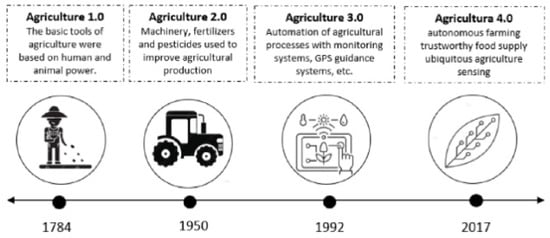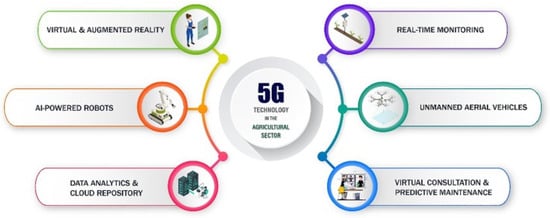Abstract
Smart farming and precision agriculture rely on the different components of IoT, such as sensors, drones, and robotic devices. IoT in agriculture is the network of interconnected devices that corresponds in real time, simultaneously, to gather, analyze, and transfer the data, which, ultimately, generate a decision to be taken by the farmer. The availability of the 4G/3G does not support the precision practices in real time due to the bandwidth, connectivity, and the speed of data-transfer issues. Further, 5G technology in the agricultural sector has put its greater influence in real-time monitoring, unmanned aerial vehicles, virtual consultation and predictive maintenance, artificially intelligent robotics, and data analytics and cloud repositories. Conclusively, the speed, connectivity, scalability and processing power, and limitations can be overcome with the availability of 5G structures.
1. Introduction
Agriculture is the main source of survival for all living beings on Earth. The systemic production of crop plants via the integration of modern technological advancements can mitigate the upcoming disasters of food security and hunger risk. The technological integration of smart agriculture, precision agriculture, 5G, and IoT can boost farm practices at the level of automation that can transform a decision-support system to optimize operations [1]. The evolutionary period of agriculture has reached the level of digital agriculture, named as “Agriculture 4.0” or digital agriculture (Figure 1) [2]. Developing countries are lacking in the adaptation of digital agriculture due to their limited sources.

Figure 1.
The evolutionary phases of agriculture [2].
Cellular communications and internet connectivity for modern times require fast services for heavy files of data transfer with high speed. These targets are now made possible to achieve by the modern fifth-generation (5G) networks, with the characteristics of achieving universal connectivity, minimum latency, and, specifically, with the highest rate of data transfer [3]. Although the technology is moving towards the next phase of the novel state-of-the-art sixth-generation (6G) network, currently, the global system is running on 5G. The IoT is completely dependent on the availability of interconnected devices that can collect, analyze, and transfer data in real time. The use of IoT in agriculture is advancing rapidly with the advent of 5G because IoT devices can perform long-range operations rapidly and reliably. Thus, 5G technology in the agricultural sector has put its greater influence in real-time monitoring, unmanned aerial vehicles, virtual consultation and predictive maintenance, artificially intelligent robotics, and data analytics and cloud repositories (Figure 2) [4].

Figure 2.
5G technology in the agriculture sector [4], copyright permission: License Number: 5411150959041; License date: 17 October 2022; Licensed Content Publisher: Elsevier.
2. Application of 5G in Agriculture
The conventional methods of agriculture are being adapted toward the new era of smart farming, which enables the production of higher yields of crops and less human interference. The components of smart farming, including sensors, collect large amounts of data and transfer them remotely in real time. This 5G technology fulfils the demand of smart farming by predicting and preventing the crops from disease damage using mobile phones. Not only this but 5G in agriculture has enormous applications, such as unmanned aerial vehicles, monitoring in real time, climate change mitigations, visual monitoring and predictive measures, artificially empowered robotics, and data analytics and cloud repository. Automated driving systems, such as autosteering tractors, deep learning, and cloud-based mobile applications, connected with 5G can further alleviate the yield outputs by many folds with maximized efficiency from farmers. Full exploration of 5G technology will define the overall productivity of precision agriculture over time [5] (Table 1).

Table 1.
Exploration of 5G and 6G technology in agricultural systems.
3. Related Work
Although developed countries are working on 5G and IoT devices in agriculture collectively to obtain their massive benefits for quantity and quality enhancements of crops, researchers are still working in the developing regions of the world to obtain the maximum output from IoT devices used in the field. The requirements of smart farming and precision agriculture were analyzed to integrate them with 5G technology for better production [4]. A protype of sustainable greenhouse was designed and implemented in Nigeria to assess the performance of IoT devices interconnected with 5G for an information-processing framework. The framework developed the artificial methods for reasoning and imaging that ultimately improved the high quality of cultivation management and ease of access to the greenhouse technology [6].
The integration of artificial intelligence and a wireless communication system was performed in the MERLIN project in India that made efficient use of 5G/6G and IoT devices. The project was run to develop a technology solution, which used cloud-based databases, namely supervised and semi-supervised, to obtain data and further process them for decision making. The decision-support system can be automated, which can improve the production and yield of the crop plants and make efficient use of remote sensors and IoT integrated with 5G/6G [7]. Smart farming was further enhanced by performing agricultural management and focusing on the development of smart systems using 5G mobile networks. The smart system was able to transfer data at a high speed, up to 20 Gbps. This system can link the enormous amount of IoT devices in a square kilometer [8].
Implementation of 5G/6G technology in Colombia boosted the use of IoT applications and increased the demand for digital agriculture. The scenarios were developed for 5G/6G usage with various bands of frequencies, their applications, and use in the farmland activities. The rural-area-based scenarios in Colombia were developed in real time for data acquisition by integrating 5G with the interconnected devices of Mobile edge and robotics that produced significant results for crop development in the remote areas of villages [8,9].
4. Challenges and Future Perspective of 5G
IoT-based devices are interconnected and wirelessly connected in a smart farm system through the availability of 4G/3G/NB-IoT. Smart devices are available for the transfer, collection of the data, precise analyses, estimation, and production of decision-supported results in farmlands. However, the networking system that interconnects these sensory systems possesses some limitations that bar the full use of precision farming technologies. The most significant limitation is the operational region because developing countries, such as Pakistan, lack the coverage of wireless networks in remote areas. City areas face the problem of connectivity, quality of services, channel conditions, and fluctuations in data-transfer rates in 4G. Another issue is the battery longevity, which is drained due to the multiple antennas and transmitters attached to the devices. IoT devices, such as robotics, drones, and field sensors, are operated remotely and remain for a longer time in the field, so cannot be sustained with the varying connectivity in 4G networks.
The connectivity issues, most importantly, hinder the advancements of precision agriculture in developing and underdeveloped regions of the world. Currently, the sensors on drones acquire images from the field and then are transferred to sprayer drones. If 5G technology is available, it can perform real-time image collection and spot spraying can be performed without lagging. Speed, connectivity, scalability, and processing power are all limitations that can be overcome with the availability of 5G structures. The global word is the old concept, while 5G is the future of the world that will soon be running every single industry for human beings.
Author Contributions
Conceptualization, S.M.Z.A.N., S.R.S. and S.H.; methodology, S.I.U.H., M.A. and S.H.; writing—original draft preparation, S.M.Z.A.N.; writing—review and editing, S.R.S., S.H. and S.L.; supervision, M.N.T., S.R.S., S.H. and S.L.; funding acquisition, M.N.T. All authors have read and agreed to the published version of the manuscript.
Funding
The study is a part of a pilot project for Data-Driven Smart Decision Platform for Increased Agriculture Productivity (DDSDP) PSDP-funded project No. 332.
Institutional Review Board Statement
Not applicable.
Informed Consent Statement
Not applicable.
Data Availability Statement
Not applicable.
Acknowledgments
The author is also very thankful to the Higher Education Commission, Islamabad, Pakistan, for supporting the study under the funded project No. 332.
Conflicts of Interest
The authors declare no conflict of interest.
References
- Arrubla-Hoyos, W.; Ojeda-Beltrán, A.; Solano-Barliza, A.; Rambauth-Ibarra, G.; Barrios-Ulloa, A.; Cama-Pinto, D.; Arrabal-Campos, F.M.; Martínez-Lao, J.A.; Cama-Pinto, A.; Manzano-Agugliaro, F. Precision Agriculture and Sensor Systems Applications in Colombia through 5G Networks. Sensors 2022, 22, 7295. [Google Scholar] [CrossRef] [PubMed]
- DayioĞLu, M.A.; Turker, U. Digital Transformation for Sustainable Future-Agriculture 4.0: A review. J. Agric. Sci. 2021, 27, 373–399. [Google Scholar] [CrossRef]
- Panwar, N.; Sharma, S.; Singh, A.K. A survey on 5G: The next generation of mobile communication. Phys. Commun. 2016, 18, 64–84. [Google Scholar] [CrossRef]
- Tang, Y.; Dananjayan, S.; Hou, C.; Guo, Q.; Luo, S.; He, Y. A survey on the 5G network and its impact on agriculture: Challenges and opportunities. Comput. Electron. Agric. 2021, 180, 105895. [Google Scholar] [CrossRef]
- Torky, M.; Hassanein, A.E. Integrating blockchain and the internet of things in precision agriculture: Analysis, opportunities, and challenges. Comput. Electron. Agric. 2020, 178, 105476. [Google Scholar] [CrossRef]
- Guo, X. Application of agricultural IoT technology based on 5 G network and FPGA. Microprocess. Microsyst. 2021, 80, 103597. [Google Scholar] [CrossRef]
- Sharma, A. MERLIN: Smart Framework for Agriculture in India. In Proceedings of the 2021 International Conference on Information and Communication Technology Convergence (ICTC), Jeju Island, Korea, 20–22 October 2021; pp. 453–457. [Google Scholar]
- Said Mohamed, E.; Belal, A.A.; Kotb Abd-Elmabod, S.; El-Shirbeny, M.A.; Gad, A.; Zahran, M.B. Smart farming for improving agricultural management. Egypt. J. Remote. Sens. Space Sci. 2021, 24, 971–981. [Google Scholar] [CrossRef]
- Valecce, G.; Strazzella, S.; Grieco, L.A. On the Interplay between 5G, Mobile Edge Computing and Robotics in Smart Agriculture Scenarios. In Proceedings of the Ad-Hoc, Mobile, and Wireless Networks, Cham, Switzerland, 1 October 2019; pp. 549–559. [Google Scholar]
Publisher’s Note: MDPI stays neutral with regard to jurisdictional claims in published maps and institutional affiliations. |
© 2022 by the authors. Licensee MDPI, Basel, Switzerland. This article is an open access article distributed under the terms and conditions of the Creative Commons Attribution (CC BY) license (https://creativecommons.org/licenses/by/4.0/).